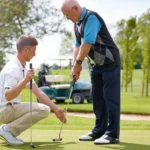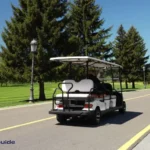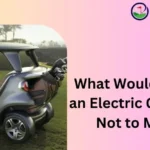What Would Cause an Electric Golf Cart Not to Move: Troubleshooting Tips and Solutions
Electric golf carts have become a popular and eco-friendly mode of transportation on golf courses, residential communities, and even in some urban settings.
These compact vehicles are known for their quiet operation, low maintenance costs, and zero emissions.
However, like any mechanical device, electric golf carts may encounter issues that hinder their smooth operation.
So, In this guide, I will delve into the various factors and potential reasons behind the question: What would cause an electric golf cart not to move? Understanding the potential issues and solutions can help keep these electric vehicles running efficiently.
Common Issues With Electric Golf Carts
Basically, Electric golf carts are a convenient and eco-friendly mode of transportation on the golf course. However, like any other vehicle, they can experience issues that prevent them from moving.
One of the main reasons why an electric golf cart may not move is due to battery problems. The battery is the heart of the cart’s power system, supplying the energy needed for the motor to operate.
So,There are a few battery-related issues that can cause a cart to come to a standstill:
- Dead or Low Battery: If the battery is dead or has a low charge, the cart won’t have enough power to move. This could be due to a battery that is old and needs replacement or could be a result of leaving the cart unused for an extended period.
- Corroded Battery Terminals: Corrosion on the battery terminals can disrupt the flow of electricity, causing the cart to lose power. Cleaning the terminals with a wire brush and applying a battery terminal protector can solve this issue.
- Loose or Damaged Battery Connections: Loose or damaged battery connections can prevent the battery from delivering power to the motor. It’s crucial to ensure all connections are tightly secured and free from damage.

What Would Cause an Electric Golf Cart Not to Move?
The motor is the driving force of the electric golf cart, but it can experience problems that result in the cart not moving. Here are a few common motor-related issues:
- Burned Out Motor: Overheating or prolonged use can cause the motor to burn out, rendering the cart immobile. Regular maintenance and proper usage can help extend the lifespan of the motor.
- Faulty Motor Controller: The motor controller regulates the flow of electricity to the motor. A malfunctioning motor controller can prevent the motor from operating correctly, leading to the cart’s inability to move.
- Loose Wiring: Loose wiring connections between the motor and the controller can interrupt the electrical circuit and halt cart movement. Checking and tightening all electrical connections can help resolve this issue.
By understanding these common issues with electric golf carts, you can troubleshoot and address the problem accordingly.
Whether it’s a battery problem, motor issue, or controller malfunction, identifying the cause and taking appropriate action will get your golf cart back on the move.
Battery Problems
Your electric golf cart not moving could be due to various reasons, and one common cause is battery problems.
The battery is the heart of your golf cart, providing the necessary power for it to move. If there are issues with the battery, it can significantly impact the cart’s performance and ability to function properly.
So, In this section, I will explore two key aspects of battery problems that can cause your electric golf cart not to move – battery charge and battery connections.
Battery Charge
The battery charge is crucial for the operation of your electric golf cart. A fully charged battery will ensure that the cart has enough power to move smoothly and efficiently.
If the battery is not charged or has a low charge, it can lead to a lack of power and ultimately result in the cart not moving at all.
There are a few potential reasons why your battery may not be adequately charged:
- The battery may be old and nearing the end of its lifespan, unable to hold a charge effectively.
- It may have been left in a discharged state for an extended period, causing it to lose its ability to hold a charge.
- There might be an issue with the charger, preventing the battery from charging properly.
- Corrosion on the battery terminals can interfere with the charging process and reduce the battery’s ability to hold a charge.
So, If your electric golf cart is not moving, one of the first things you can check is the battery charge.
Ensure that the battery is fully charged, and if not, try charging it using a functioning charger. If the battery is old or does not hold a charge despite being charged properly, it might be time to consider replacing it.

Battery Connections
Basically, The battery connections play a crucial role in delivering the necessary power to your electric golf cart.
If there are issues with the connections, it can impede the flow of electricity, causing the cart not to move. Here are some potential problems related to battery connections:
- Loose or corroded battery terminal connections can disrupt the electrical flow and prevent the battery from powering the cart.
- Worn or damaged cable connectors can hinder the transfer of electricity, resulting in a lack of power to move the cart.
- Faulty wiring or loose connections between the battery and the cart’s motor can lead to a disruption in the electrical circuit, affecting the cart’s movement.
So, If your electric golf cart is not moving, it is essential to inspect the battery connections. Ensure that the battery terminals are tight, clean, and free from corrosion.
Additionally, inspect the wiring between the battery and the motor to ensure there are no loose connections or damaged wires.
Motor Issues
Electric golf carts are convenient and efficient vehicles for transportation on the green.
However, motor issues can cause these carts to malfunction, preventing them from moving. A malfunctioning motor can be caused by a variety of factors.
Brushes And Commutator
One of the common issues that can cause an electric golf cart to not move is problems with the brushes and commutator in the motor.
Brushes play a vital role in conducting electricity to the commutator, which then powers the motor. If the brushes are worn out or damaged, they can prevent the necessary electrical current from reaching the commutator, thereby impeding the motor’s functionality.
Similarly, a faulty or dirty commutator can disrupt the flow of electricity within the motor, leading to movement issues with the golf cart.
Regular maintenance and inspection of these components can help identify and address potential issues before they escalate, keeping the cart in optimal working condition.
Electrical Wiring
Another motor-related factor that can cause an electric golf cart to be immobilized is problems with the electrical wiring.
Frayed or damaged wiring can interrupt the flow of electricity to the motor, hindering its ability to function properly.
It’s important to regularly inspect the electrical wiring for any signs of wear and tear, as well as secure connections to ensure an uninterrupted power supply to the motor.

Controller Malfunctions
Generally, There are several potential causes for a golf cart’s lack of movement. One of the common issues is a malfunctioning controller, which can result in a loss of power and prevent the cart from moving forward or backward.
Proper diagnosis and repair of the controller can restore the cart’s functionality.
Controller malfunctions are common causes of electric golf carts not moving properly. The controller is a crucial component that regulates the power flow from the battery to the motor.
So, If the controller malfunctions, it can disrupt this flow, resulting in the cart’s immobility. Two common controller malfunctions that can cause an electric golf cart not to move are the solenoid and relay issues and the throttle sensor problems.
Solenoid And Relay
The solenoid and relay are essential components of the controller that play a significant role in controlling the power flow.
These parts are responsible for connecting and disconnecting the current between the battery and motor.
If there is a problem with the solenoid or relay, the power flow may be disrupted, causing the cart not to move. Possible issues with the solenoid and relay include:
- Faulty Wiring: Loose or damaged wiring connections can prevent the solenoid and relay from functioning correctly.
- Check for any loose wires or frayed connections. Ensure that all connections are secure, and replace any damaged wiring as necessary.
- Corrosion: Over time, corrosion can build up on the solenoid and relay, impairing their performance.
Inspect the components for any signs of corrosion, such as rust or greenish deposits. Clean the affected areas using a wire brush or appropriate cleaning solution.
- Defective Solenoid or Relay: In some cases, the solenoid or relay may be defective due to internal issues.
If you suspect a defective component, it is recommended to consult a professional technician for diagnosis and replacement.
Throttle Sensor
The throttle sensor, also known as the throttle position sensor (TPS), is responsible for relaying the position of the accelerator pedal to the controller.
It determines the speed at which the motor should propel the cart. Any malfunction or discrepancy in the throttle sensor can result in the cart not moving or moving inconsistently.
So, Here are some possible causes of throttle sensor malfunctions:
- Loose or Damaged Wiring: Check for any loose or damaged wiring connections related to the throttle sensor.
If there are any loose wires or frayed connections, ensure they are securely connected or replaced.
- Dirty or Malfunctioning Sensor: Dirt, debris, or wear and tear can affect the performance of the throttle sensor.
Clean the sensor using appropriate cleaning solutions and ensure it is functioning correctly. If cleaning does not resolve the issue, consider replacing the throttle sensor.
- Misaligned Sensor: Sometimes, the throttle sensor can become misaligned, which can lead to inaccurate readings.
Consult the manufacturer’s guidelines or seek professional assistance to realign the sensor properly.
If your electric golf cart is not moving, it is essential to check for controller malfunctions. Problems with the solenoid and relay or the throttle sensor can cause the cart’s immobility.
At last, By addressing these issues, you can restore the proper functioning of your golf cart and get back on the course in no time.
Testing And Diagnosis
If your electric golf cart is not moving, it may be due to various issues. Check the battery, motor, and controller for any faults.
To ensure a proper diagnosis, perform thorough testing of these components. Look for loose connections, malfunctioning parts, or electrical issues that may be causing the problem.
Electric golf carts are designed to provide a smooth and efficient ride on the golf course. However, there may be times when your electric golf cart refuses to move, leaving you stranded.
So, In such situations, it is important to conduct thorough testing and diagnosis to identify the cause of the problem.
At last , This will help you understand why your golf cart is not moving and take appropriate measures to rectify the issue.
Voltage Testing
Basically, One of the first steps in diagnosing the issue with your electric golf cart is to perform voltage testing.
So, This involves checking the voltage levels of the batteries to ensure they have enough power to run the cart. To do this, follow these steps:
- Locate the battery compartment of your golf cart.
- Using a multimeter set to the DC voltage setting, connect the red positive probe to the positive terminal of the first battery and the black negative probe to the negative terminal.
- Read the voltage displayed on the multimeter. A fully charged battery should read around 12.6 to 12.8 volts.
- Repeat this process for each battery in the cart, ensuring that each battery has a similar voltage reading.
Component Inspection
If your voltage testing reveals that the batteries are fully charged and working properly, the next step is to inspect the various components of your electric golf cart.
Some potential causes for your cart not moving could be a faulty controller, motor, or solenoid. Here’s how you can inspect these components:
Controller
Inspect the controller, which is responsible for regulating the flow of electricity to the motor. Look for any signs of damage or loose connections.
Pay special attention to the wiring and ensure that there are no loose or disconnected wires. If you notice any issues, it may be necessary to repair or replace the controller.
Motor
Check the motor for any signs of damage or debris. Ensure that the motor is securely connected and that all wiring is intact.
If you suspect a problem with the motor, it is advisable to seek professional assistance for repairs or replacement.
Solenoid
The solenoid controls the flow of electricity from the batteries to the motor. Inspect the solenoid for any signs of damage or loose connections.
Make sure that the wiring is properly connected and that there are no frayed wires. If you identify any issues with the solenoid, it may need to be repaired or replaced.
By conducting these voltage tests and inspecting the various components, you can pinpoint the cause of your electric golf cart not moving.
Remember, if you are unsure or unable to diagnose the issue yourself, it is always best to consult a professional for assistance.
Maintenance And Preventive Measures
When it comes to ensuring the optimal performance and longevity of your electric golf cart, regular maintenance and preventive measures play a crucial role.
By implementing these strategies, you can significantly reduce the chances of encountering issues that may lead to your golf cart not moving.
Let’s take a closer look at some essential maintenance and preventive measures that can help keep your electric golf cart in top condition.
Regular Battery Check-ups
Proper maintenance of the battery is key to ensuring that your electric golf cart operates smoothly.
Conduct regular battery check-ups to inspect for any signs of corrosion, loose connections, or damage.
Additionally, make sure to keep the battery clean and free from debris and dirt to prolong its lifespan and optimize performance.
Motor Cleaning And Lubrication
Regular cleaning and lubrication of the motor can help prevent issues that may hinder the movement of your electric golf cart.
Make it a point to clean the motor and its components, removing any accumulated dust and debris.
Furthermore, apply a suitable lubricant to the moving parts of the motor to minimize friction and ensure efficient operation.
Professional Help And Servicing
If you’ve exhausted all possible DIY troubleshooting and your electric golf cart still refuses to budge, it’s time to seek professional help and servicing.
In some cases, the problem may be too complex or requires specialized equipment and knowledge, making it crucial to entrust the repair to a qualified technician.
Additionally, exploring manufacturer support can provide valuable assistance and insight specific to your golf cart model.
How to make electric golf cart faster?
Let’s dive into the world of electric golf carts and discover how to unlock their full potential for speed and efficiency.
Check Your Tires:
Make sure your golf cart’s tires are filled with enough air. Proper tire pressure helps the cart move more efficiently.
Get Better Batteries:
Consider upgrading to special batteries that can give your golf cart more power. It’s like giving it a little energy boost.
Upgrade the Motor and Brain:
Think of your golf cart’s motor and controller as its muscles and brain. Upgrading these parts can make it stronger and smarter, helping it go faster.
Change the Gears:
Imagine your golf cart has gears like a bicycle. Adjusting these gears can make it go faster, but be careful not to mess with it too much.
Add a Speed Controller:
Installing a speed controller is like giving your golf cart a little turbo boost. It helps control how fast it can go.
Remove Speed Limits:
Some carts have built-in limits for safety. If it’s allowed in your area, you might be able to remove or adjust these limits to let your cart go faster.
Make It More Aerodynamic:
If you want to get a bit fancy, adding things like a windshield can help your cart move through the air more smoothly, making it faster.
Ask the Experts:
If you’re not sure what to do, it’s like going to a doctor when you’re sick. Consult with a professional who knows about golf carts. They can help you make the right changes without causing any problems.
Remember, safety first! Going too fast can be fun, but it’s important to make sure your golf cart can handle it safely.
How to store an electric golf cart for 6 months?
Alright, here’s a quick and simple guide to storing your electric golf cart for six months:
Clean It Up:
Give your golf cart a good cleaning to keep it fresh and ready for use later.
Charge the Batteries:
Before storing, make sure the batteries are fully charged. Disconnect them if you can.
Top Off Fluids:
Check and fill up brake fluid, coolant, and other fluids to keep things running smoothly.
Oil the Joints:
Lubricate moving parts to prevent rust and ensure everything works well after storage.
Inflate the Tires:
Pump up the tires to the right pressure to avoid flat spots during the break.
Find a Good Spot:
Store the cart in a cool, dry place away from direct sunlight to protect it from the elements.
Use a Charger:
If you have one, use a battery maintainer or trickle charger to keep the battery in good shape.
Lift It Up:
If you can, lift the cart a bit to ease pressure on the tires and prevent flats.
Cover It:
Put a breathable cover on it to shield from dust and scratches. Let it breathe to avoid mold.
Pest-Proof:
Keep rodents away with mothballs or repellents to prevent any unwanted surprises.
Finding A Qualified Technician
When it comes to getting your electric golf cart back on track, finding a qualified technician is paramount.
These professionals possess a deep understanding of golf cart mechanics and have the necessary expertise to diagnose and rectify a wide range of issues.
Seek referrals from fellow golf cart owners, friends, or family if you’re unsure where to start. Another option is to consult local golf cart dealerships or repair shops specializing in electric vehicles.
These establishments often have experienced technicians who can provide the required expertise.
Furthermore, online directories and review platforms can aid in your quest for a reliable technician.
Look for professionals who have garnered positive reviews, exemplifying their skill and trustworthiness.
Take the time to verify their qualifications and certifications, ensuring they meet industry standards.
Seeking Manufacturer Support
If your electric golf cart is still under warranty or you prefer the guidance of the manufacturer, seeking manufacturer support can be advantageous.
Manufacturers often offer technical assistance, service centers, or authorized dealerships to cater to their customers’ needs.
Start by checking the manufacturer’s website for any support options they provide. This may include detailed troubleshooting guides, service manuals, or contact information for their support team.
Reach out to their customer service helpline or email, detailing the issues you’re facing with your golf cart.
If necessary, they may recommend bringing your cart to an authorized service center or dealership.
These establishments have the advantage of having direct access to manufacturer-specific tools, parts, and in-depth knowledge about the particular model.
Related Post
How to speed up a golf cart | Accelerate Your Golf Cart Adventure
Frequently Asked Questions Of What Would Cause An Electric Golf Cart Not To Move
How Do I Troubleshoot An Electric Golf Cart That Won’t Move?
To troubleshoot an electric golf cart that won’t move, first, check the battery connection, throttle, and solenoid functionality.
Why Is My Electric Golf Cart Not Accelerating?
If your electric golf cart is not accelerating, it could be due to a faulty speed controller, damaged motor, or low battery voltage.
What Can Cause An Electric Golf Cart To Lose Power?
An electric golf cart can lose power due to depleted batteries, motor issues, worn-out solenoids, or a faulty charger.
How Do I Fix A Golf Cart That Is Stuck In Reverse?
To fix a golf cart stuck in reverse, check the forward/reverse switch and wiring connections, ensuring they are securely connected.
Why Does My Electric Golf Cart Make A Clicking Noise But Won’t Move?
If your electric golf cart makes a clicking noise but doesn’t move, it may indicate a malfunctioning solenoid or a problem with the motor controller.
A final thought about What Would Cause an Electric Golf Cart Not to Move.
It’s important to troubleshoot electric golf carts to ensure smooth functionality. Regular maintenance and a thorough electrical system check can help identify issues early.
So, Understanding common problems like battery failure and motor issues can save time and money. By following these steps, you can keep your electric golf cart moving effortlessly.












